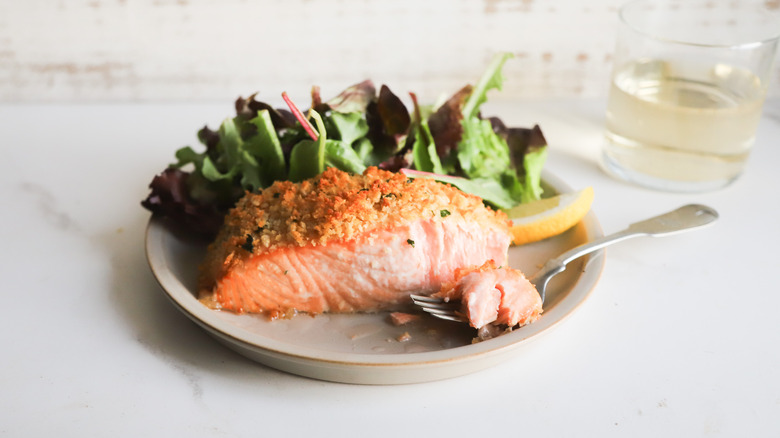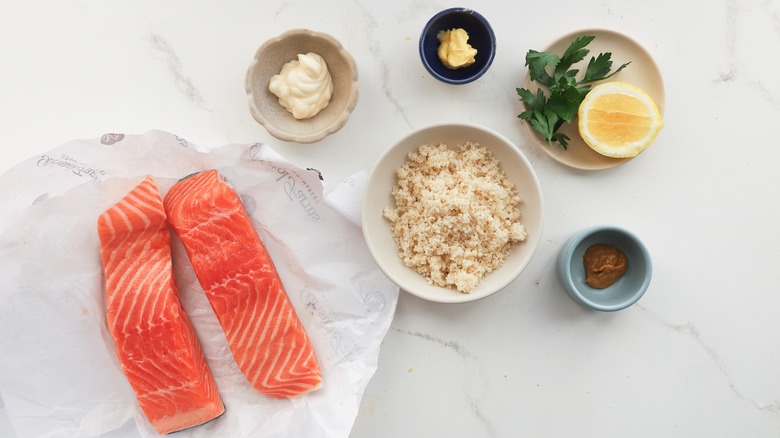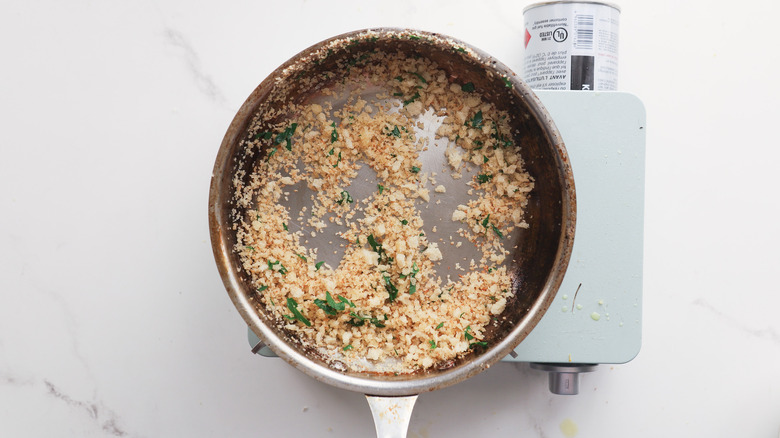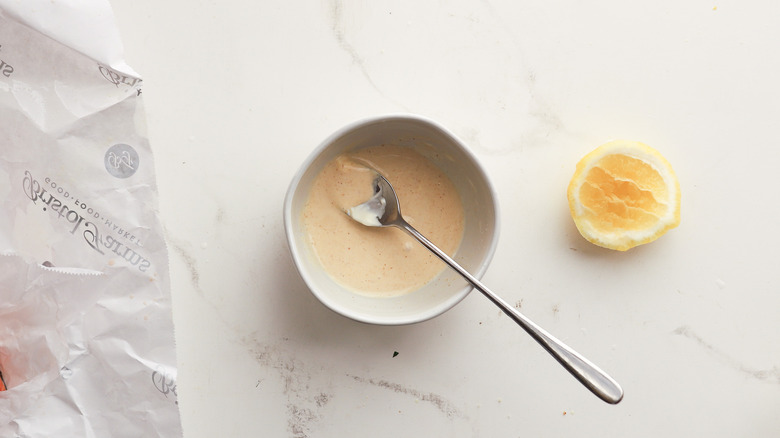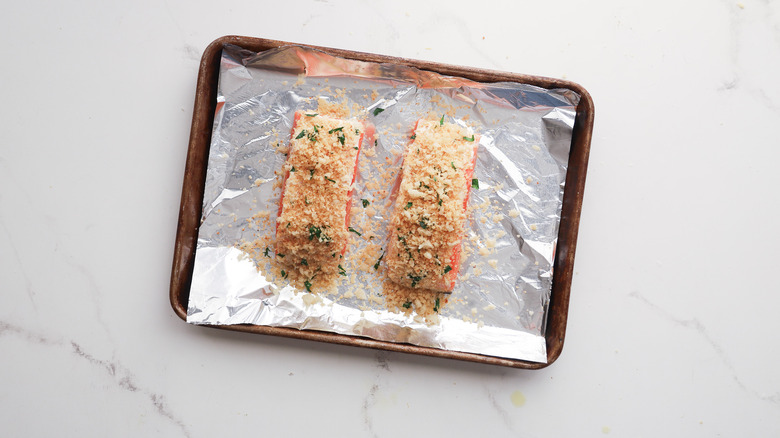Simple Dijon-Crusted Salmon Recipe
Salmon, revered for its rich flavor profile, has always been a favorite among seafood enthusiasts and home cooks alike. The most common ways to prepare salmon often involve simple grilling, pan-searing, steaming, or poaching. These methods, while classic and delicious, are all great, but can be somewhat time-consuming and daunting for a busy weeknight. Baking salmon offers simplicity, but visually, the results can sometimes leave a lot to be desired. To elevate this, try coating a Dijon mustard-slathered fillet in golden breadcrumbs. The result? A stunning fillet of salmon that captivates both the palate and eye with very little effort.
Once prepped, the salmon can be left to gently roast in the oven, giving you a moment to relax and anticipate a delightful meal. The final dish is a beautifully crispy salmon, striking the perfect balance between gourmet flair and healthful dining. Recipe developer Taylor Murray guides us through her favorite, stress-free way to cook salmon.
Gather the ingredients for Dijon-crusted salmon
First, choose your salmon fillets. When choosing salmon, freshness is paramount. Look for a good color; Depending on the variety, fresh salmon can range from deep reddish-orange to a lighter pink. Wild-caught salmon, like sockeye, tends to be darker compared to farm-raised salmon. The flesh should be firm to the touch, springing back when pressed. Fresh salmon should have a clean oceanic smell. Avoid fish that has a strong, fishy odor, as this is a sign it's past its prime.
Opt for fresh breadcrumbs rather than dry ones as they give a more delicate crust. You can make these by processing a few slices of day-old bread in a food processor. Butter adds a richness to the breadcrumb mixture and helps it brown nicely when roasting. It's advisable to use unsalted butter, so you have more control over the salt content of your dish. Fresh parsley provides a burst of color and a subtle herby flavor. Always choose vibrant green parsley without any signs of wilting.
The creaminess of mayonnaise contributes to the moistness of the crust and binds the ingredients together. Opt for good quality mayo for a rich flavor. The heart of the crust, Dijon mustard, offers a sharp and tangy flavor, elevating the taste profile of the salmon. A hint of acidity from lemon juice balances the richness of the other ingredients and complements the flavor of the salmon — freshly squeezed is always best.
Prepare the breadcrumbs
Heat the oven to 400 F as you prepare the rest of the dish. While the oven heats, melt the butter over medium heat in a small pan. Once melted, add the breadcrumbs to the pan, stirring them thoroughly to ensure they're evenly coated in the butter. This even coating is vital for achieving a consistent golden texture during toasting. As you toast the breadcrumbs, keep an eye on their color, aiming for a light brown hue.
Given the breadcrumbs' propensity to toast quickly due to the high fat content of the butter, it's crucial to monitor them closely to prevent burning. Once they start to brown, stir in the fresh parsley to the mixture. The parsley offers a pop of color and a mild, herby flavor against the toasted breadcrumbs. After stirring in the parsley, remove the pan from the heat and set it aside.
Make the mayonnaise-Dijon mixture
The next step is to make the mayonnaise mixture. This mixture will add flavor as well as provide a sort of "glue" that will allow the breadcrumbs to stick to the salmon. The base of this mixture is mayonnaise, which provides richness and a silky texture, and keeps the mustard from tasting too sharp. The next ingredient is our star, the Dijon mustard. Don't substitute this with yellow mustard, as the flavor is not the same and it will skew the final result. Spring for some high-quality French mustard, if possible. The final ingredient is a hit of fresh lemon juice, because salmon loves a nice punch of acidity to cut through the fatty, rich flavor.
Bake and serve the Dijon-crusted salmon
Line a baking sheet with aluminum foil to save yourself some time cleaning later. Lay the salmon fillets on the foil, skin side down. Use a spoon to spread the mayonnaise mixture all over the top of the salmon. You can also spread it on the sides, if you wish, but you'll have to work a little harder to get the breadcrumbs to stick to the sides. "I like to just have the crumbs on top so I can have a nice visual contrast between the pink salmon and the toasty breadcrumbs, but that is a personal choice and totally up to you," says Murray.
When the mixture is spread, top with the bread crumbs. Transfer the salmon to the oven and bake until cooked through and a thermometer inserted into the center reads 135 F. Remove from oven and allow to cool slightly. Serve the salmon with roasted potatoes, sauteed asparagus, or just a simple green salad. The salmon will keep covered in the refrigerator up to three days and can be reheated in the oven at the same temperature it baked at.
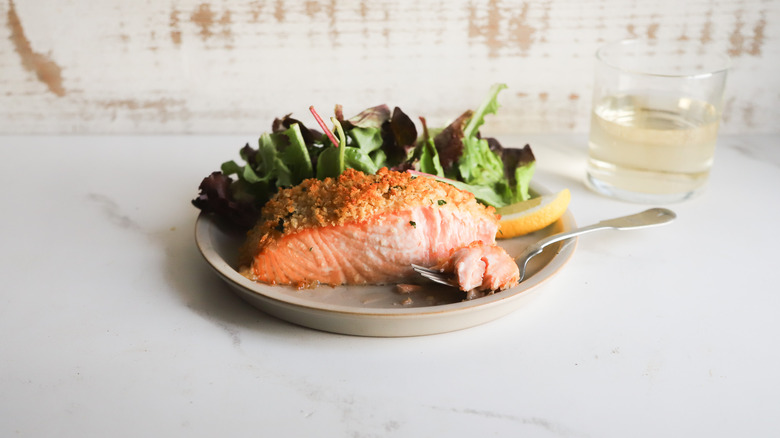
- 2 teaspoons butter
- ⅓ cup breadcrumbs
- 1 teaspoon finely chopped parsley
- 2 tablespoons mayonnaise
- 1 ½ teaspoons Dijon mustard
- 1 teaspoon lemon juice
- 2 (6-ounce) salmon fillets
- Preheat the oven to 400 F.
- In a small pan, melt the butter over medium heat. Add the breadcrumbs and stir to coat. Continue to toast the breadcrumbs until just starting to brown. Stir in the parsley and set aside.
- In a small bowl, whisk together the mayonnaise, mustard, and lemon juice. Set aside.
- Line a rimmed baking sheet with aluminum foil. Place the salmon fillets on the foil. Use a spoon to rub the mayonnaise mixture all over the top of the salmon. Sprinkle the breadcrumbs over the salmon and press to ensure they adhere.
- Transfer the salmon to the oven and bake until salmon is cooked through, about 15 minutes. Remove from oven and let cool slightly before serving.
| Calories per Serving | 562 |
| Total Fat | 38.8 g |
| Saturated Fat | 9.5 g |
| Trans Fat | 0.0 g |
| Cholesterol | 109.4 mg |
| Total Carbohydrates | 13.4 g |
| Dietary Fiber | 1.0 g |
| Total Sugars | 1.2 g |
| Sodium | 357.6 mg |
| Protein | 37.3 g |

